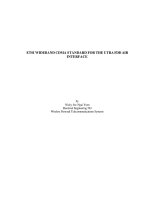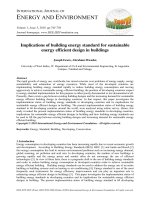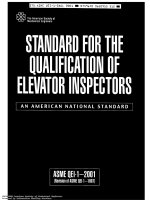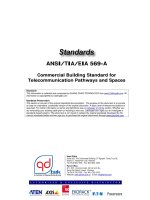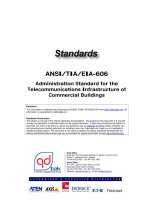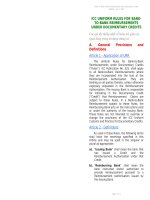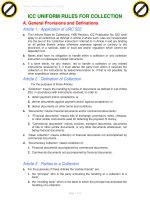UNIFORM STANDARD FOR WOOD CONTAINERS
Bạn đang xem bản rút gọn của tài liệu. Xem và tải ngay bản đầy đủ của tài liệu tại đây (1.3 MB, 51 trang )
<span class="text_page_counter">Trang 2</span><div class="page_container" data-page="2">
<b>Copyright © 2012 by the National Wooden Pallet and Container Association </b>
All rights reserved. No part of this book may be reproduced or transmitted in any form or by any means, electronic or mechanical, including photocopying, recording, or by an information storage and retrieval system, without permission in writing from the National
Wooden Pallet and Container Association.
<b>National Wooden Pallet and Container Association </b>
Printed in the United States of America
Wood containers are manufactured or repaired for the sole purpose of storing and/or transporting material. Under no circumstances should any person stand, step, or lean upon them or otherwise use them for support. The wood container user has the obligation and responsibility to inspect for damage prior to each container use and to determine that the container design is appropriate for that particular unit load application. All wood containers should be removed from service if determined to be unsafe and dangerous to persons or goods.
</div><span class="text_page_counter">Trang 3</span><div class="page_container" data-page="3"><b>DISCLAIMER </b>
This standard was approved by NWPCA on May 2012. It was developed with the sole intent of offering information to parties engaged in the manufacture, recycling, marketing, purchase, or use of wood containers. This standard is advisory only and acceptance is voluntary and the standard should be regarded as a guide that the user may or may not choose to adopt, modify, or reject. The information does not constitute a comprehensive safety program and should not be relied upon as such. Such a program should be developed and an independent safety adviser consulted to do so. NWPCA Standards Committee and its staff and members assume no responsibility and disclaim all liability of any kind, however arising, as a result of acceptance or use or alleged use of this standard. User specifically understands and agrees that NWPCA, Standards Committee and its staff and members shall not be liable under any legal theory of any kind for any action or failure to act with respect to the design, installation, manufacture, preparation for sale, sale, characteristics, features, or delivery of anything covered by this standard. Any use of this information must be determined by the user to be in accordance with applicable federal, state, and local laws and regulations.
NWPCA, the Standards Committee and its staff and members make no warranties of any kind, express, implied, or statutory, in connection with the information in this standard. NWPCA and the Standards Committee specifically disclaim all implied warranties of merchantability or of fitness for particular purpose.
By referring to or otherwise employing this standard, the user agrees to defend, protect, indemnify, and hold NWPCA, the Standards Committee, their staff and members harmless from and against all claims, losses, expenses, damages, and liabilities, direct, incidental, or consequential, arising from acceptance or use or alleged use of this standard, including loss of profits and reasonable attorneys' fees which may arise out of the acceptance or use or alleged use of this standard. The intent of this provision and of the user is to absolve and protect NWPCA, the Standards Committee, their staff and members from any and all loss relating in any way to this standard, including those resulting from the user's own negligence.
</div><span class="text_page_counter">Trang 4</span><div class="page_container" data-page="4"><b>NATIONAL WOODEN PALLET AND CONTAINER ASSOCIATION STANDARDS COMMITTEE </b>
<b>2012 </b>
(The following is the roster of the Committee at the time of approval of this version.)
<b>Members </b>
<b>Jordan Piland (Chair), Atlas Pallets </b>
<b>Gunilla Beyer, Swedish Forest Industries Federation Tony Butterfield, Nortwest Hardwoods Ian Carter, Crane Point Industrial, LLC LeRoi Cochran, IFCO Systems, N.A. Inc. </b>
<b>John Conway, Conway & Robison, LLC Louis Glascock, Dodd Saw Mills, Inc. </b>
<b>Stan Joray, Ox Box Niels Jorgensen, Kiln-Direct.com Al Longman, Pallet Central Enterprises </b>
<b>Dan Konz, Konz Wood Products Matt McGowan, Timber Products Inspection Bill Schneider, Remmey - The Pallet Company </b>
<b>Danny Sparrow, Neal’s Pallet Company </b>
<b>Staff Liaison Edgar Deomano, PhD </b>
</div><span class="text_page_counter">Trang 5</span><div class="page_container" data-page="5"><b>TABLE OF CONTENTS </b>
<b><small>1PURPOSE ... 1</small></b>
<b><small>2SCOPE ... 1</small></b>
<b><small>PART I PRESCRIPTIVE STANDARD ... 2</small></b>
<b><small>3TERMINOLOGY AND DEFINITION ... 2</small></b>
<b><small>4CONTAINER CLASSIFICATIONS ... 8</small></b>
4.1 Box 8 4.2 Crate 18 4.3 Wirebound Container Style (ASTM D 6573) 20 4.4 Wirebound Pallet-type Box (ASTM D 6254) 22 4.6 Load type (ASTM D 996, D 6251) 22 4.7 Destination class (ASTM D 6251, D 6256 and D 6573) 22 <b><small>PART II. PERFORMANCE STANDARD ... 34</small></b>
<b><small>7CONDITIONS OF CONTAINER USE ... 34</small></b>
<b><small>PART III PHYTOSANITATION STANDARD ... 37</small></b>
<b><small>10PHYTOSANITATION OF WOOD CONTAINERS ... 37</small></b>
10.1 Debarked 37 10.2 Heat Treatment 37 10.3 Methyl Bromide (MB) Fumigation 37 10.4 New Wood Containers 38 10.5 Recycled wood containers 38
</div><span class="text_page_counter">Trang 6</span><div class="page_container" data-page="6"><b>1 PURPOSE </b>
The purpose of this Uniform Standard for Wood Containers (hereinafter referred to as the Standard) is to establish nationally recognized minimum quality requirements for the principal types of wood containers and to provide a basis for common understanding among manufacturers, repairers, distributors, and users of wood containers.
This Uniform Standard applies only to new wood containers as well as their lumber components, panels, and fasteners. Criteria contained in this Standard are applicable only at the completion of manufacture.
This Standard is in three parts. Part I is the Prescriptive Standard that concerns the manufacture of the container. This includes container terminologies, definitions, classifications, material descriptions, manufacture and assembly requirements. Part II is the Performance Standard that concerns the functionality of the container. This contains references to the physical testing to assist manufacturers, recyclers , distributors, and users to determine the performance level of a specified container. Use of the Performance Standard is required for new container constructions, along with conformance to Part I of the Prescriptive Standard. Part III covers Phytosanitation of Wood Containers.
This Standard does not describe other established special requirements for export containers, and does not address the safety problems, if any, associated with the use of wood container. It is the responsibility of the user of this Standard to establish appropriate safety and health practices and determine the applicability of regulatory limitations prior to its use.
To assist the user of this Standard, other related standards and specifications are listed in Annex A.
In any dispute regarding dimensions of components or defects, the U.S. customary units are governing.
</div><span class="text_page_counter">Trang 7</span><div class="page_container" data-page="7"><b>PART I PRESCRIPTIVE STANDARD </b>
<i>base – lower portion of the container on which its content rests </i>
<i>batten – reinforcement on wood containers used to hold a series of boards together to </i>
create rigidity – generally set in from each end to prevent board splitting. When used flushed with the end it becomes a cleat.
<i>blank – a flat unassembled pallet box exclusive of pallet base and top </i>
<i>box – a container with structural framework and panel members fastened together to form </i>
a rigid enclosure. The panels used to create this enclosure can be made of corrugated paper, plywood, OSB or any product strong enough to perform containment of given products. Most boxes are fully enclosed and can have any section (i.e. side, end, top, base and cap) removable for filling.
Figure 1. Typical wood box with principal parts labeled.
<i>cleat – a piece of lumber used to strengthen or support the framework of a container batten cleat – cleat oriented perpendicular to the lumber sheathing in order to </i>
provide rigidity to the lumber
<i>diagonal cleat – cleat oriented diagonally to the lumber sheathed panel for added </i>
lateral support to the panel
<i>filler edge cleat - cleat oriented flush with edge of a panel, but placed between the </i>
through edge cleat.
<i>framing cleat – a cleat positioned at or near the edge of a panel with the intent of </i>
adding rigidity to the panel and increase the surface for fastening
</div><span class="text_page_counter">Trang 8</span><div class="page_container" data-page="8"><i>intermediate cleat – cleat which is placed between through edge cleats and/or </i>
filler edge cleats to reduce unsupported span.
<i>support cleat – a cleat positioned anywhere other than at the edge of a panel through edge cleat – cleat that run the full length of a panel and are positioned </i>
flush with the panel edge
Figure 2. Types of cleats.
<i>container – a general wood packaging terminology for a receptacle designed for efficient </i>
handling or storage of cargo.
<i><b>container dimensions – interior container measurements typically expressed as length x </b></i>
width x height
<i><b>container height – container measurement from top to bottom </b></i>
<i>container length – container measurement from left to right or perpendicular to </i>
runners if required
<i>container width – container measurement from front to back </i>
<i>crate – a container with structural framework fastened together to form a rigid structure </i>
enclosure. Typically having an open construction concept with little or no panel support.
</div><span class="text_page_counter">Trang 9</span><div class="page_container" data-page="9">Figure 3. Typical wood crate with principal parts labeled.
<i>diagonals – angle members placed between vertical and horizontal members within a </i>
section or panel to provide rigidity to the container
<i>ends – composed of faceboards to which battens or cleats are attached forming a </i>
structural component along the width of a container
<i>faceboards – sheathing boards used for the top, bottom, sides and ends of a container floorboards – sheathing for the base fastened to the skids </i>
<i>header – end cross members of the base. Headers are bolted to the skids and act as </i>
fastening members for assembly of the end panels.
<i>joists – load-supporting members of the top, spanning the width of the crate </i>
<i>liner – thin board stapled to the end to reinforce the end faceboard of wirebound </i>
containers
<i>member – parts that form the fundamental structure of both sheathed and open crate – </i>
members are typically boards. This terminology can also refer to export boxes where structure is inside panel or sheathing.
<i>bottom/lower member - horizontal members at the bottom of the side and end </i>
panels
<i>cross member - member running perpendicular to longitudinal members </i>
<i>end member – edge crosswise member of the top, located at each end of the panel </i>
</div><span class="text_page_counter">Trang 10</span><div class="page_container" data-page="10"><i>intermediate member – lengthwise members of the top, located between the side </i>
members
<i>longitudinal member - lengthwise member of any panel </i>
<i>side member – edge members of a top without a joist, parallel to the length in </i>
sheathed containers.
<i>top/upper member – horizontal members at the top of the side and end panels pallet base – base of a pallet box </i>
<i>pallet box – a container with minimum openings an any face of the blank and having a </i>
pallet base to facilitate handling with mechanical equipment. Can also refer to a bulk container made from either lumber, plywood or cleated plywood sheathed material.
<i>pallet collars – lumber or wood-based components fastened together with hinges to form </i>
the walls of a rigid or folding structure placed on top of a pallet.
<i>sides – composed of faceboards or panels to which battens or cleats are attached forming </i>
a structural component along the length of a container
<i>sill base – framework of load-bearing members called side, end and intermediate sills. sills – member that, along with the sill bridging, form the framework of sill-base. </i>
<i>skid base – consists of longitudinal skids that are assembled with such cross members as </i>
headers, load-bearing floorboards, diagonals and plywood or lumber flooring
<i>skids – lengthwise members of the base </i>
<i>strut – members placed vertically between upper and lower members top - top most panel of any container. Also referred by “lid” or “cover” </i>
<i>wirebound container – May be in the form of a box, crate or pallet box. Manufactured by </i>
stapling faceboards, liners or panels together with cleats and battens with a binding wire. Produced in mat form these containers are assembled with a twist wire or loop-type closure.
</div><span class="text_page_counter">Trang 11</span><div class="page_container" data-page="11">Figure 4. Typical pallet box with principal parts labeled.
</div><span class="text_page_counter">Trang 12</span><div class="page_container" data-page="12"><b>Figure 5. Typical wirebound container with principal parts labeled. </b>
</div><span class="text_page_counter">Trang 13</span><div class="page_container" data-page="13"><b>4 CONTAINER CLASSIFICATIONS </b>
<b>4.1.1 Cleated panel box style (ASTM D 6251 wood-cleated panelboard boxes) </b>
- Style A – this standard corner box style is the most common and with the correct filler panel can be built 48” in any direction before adding more structural cleats. Horizontal cleats give the panel rigidity but most of the strength comes from the corners. When increasing sizes, supports cleats or thicker panels may be used.
Figure 6. Style A cleated panel box (ASTM, 2006).
- Style B – box with interlocking three-way corners.
Figure 7. Style B cleated panel box (ASTM, 2006).
</div><span class="text_page_counter">Trang 14</span><div class="page_container" data-page="14">- Style C – the removal of cleats generally means a lighter duty application. However, the increase the panel thickness or product type can achieve certain desired results.
Figure 8. Style C cleated panel box (ASTM, 2006)
- Style E – this box style with the top having two cleats allows for the base to be locked in for stacking. For added strength, place vertical cleat inline with runner or riser to drive loads to ground level.
Figure 9. Style E cleated panel box (ASTM, 2006)
</div><span class="text_page_counter">Trang 15</span><div class="page_container" data-page="15">- Style F – additional cleats add rigidity to the panel product.
Figure 10. Style F cleated panel box (ASTM, 2006)
- Style G – interior cleating, commonly used for export shipments.
<b>4.1.2 Box cleating arrangement (ASTM D 6256 wood-cleated boxes with skidded, load-bearing bases) </b>
- Regular cleating
Figure 11. Regular cleating (ASTM, 2006)
- Lock corner cleating
Figure 12. Lock corner cleating (ASTM, 2006)
</div><span class="text_page_counter">Trang 16</span><div class="page_container" data-page="16"><b>4.1.3 Nailed wood box style (ASTM D 6880 wood boxes) </b>
- Style 1 – uncleated ends
Figure 13. Style 1 nailed box
</div><span class="text_page_counter">Trang 17</span><div class="page_container" data-page="17">- Style 2 – full cleated ends, butt joints
Figure 14. Style 2 nailed box
</div><span class="text_page_counter">Trang 18</span><div class="page_container" data-page="18">- Style 2 ½ - full cleated ends, notched cleats
Figure 15. Style 2 ½ nailed box.
</div><span class="text_page_counter">Trang 19</span><div class="page_container" data-page="19">- Style 4 – two exterior cleat ends
Figure 15. Style 4 nailed box
</div><span class="text_page_counter">Trang 20</span><div class="page_container" data-page="20">- Style 4 ½ - horizontal exterior cleat ends
Figure 17. Style 4 ½ nailed box.
</div><span class="text_page_counter">Trang 21</span><div class="page_container" data-page="21">- Style 5 – interior end cleats
Figure 18. Style 5 nailed box.
</div><span class="text_page_counter">Trang 22</span><div class="page_container" data-page="22">- Style 7 – skidded base with separate hood
Figure 19. Style 7 nailed box.
<b>4.1.4 Box panel composition type (ASTM D 6251) </b>
- Type I - Corrugated plastic
- Type II - Corrugated and solid fiberboard
- Type III - Plywood
- Type IV - Oriented Strand Board (OSB)
<b>4.1.5 Box base type (ASTM D 6256) </b>
- Type I - Plywood base
- Type II - Lumber base
</div><span class="text_page_counter">Trang 25</span><div class="page_container" data-page="25"><b>4.2.2 Heavy duty sheathed crate type (ASTM D 7478) </b>
- Type I – nailed
- Type II – bolted
<b>4.2.3 Heavy duty sheathed crate type (ASTM D 7478) </b>
- Class I – lumber sheathed
- Class II – plywood sheathed
<b>4.2.4 Heavy duty sheathed crate type (ASTM D 7478) </b>
- Style A – skid base
- Style B – sill base
<b>4.3 Wirebound Container Style (ASTM D 6573) </b>
- Style 1 - twisted wire closure
Figure 23. Style 1 wirebound box (ASTM, 2064)
</div>